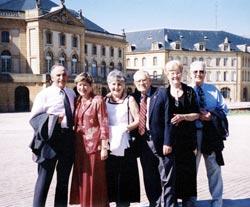by Manuel Marquez-Sterling

The “Plymouth Six” at the Opera in Metz for the performance of Les Huguenots by Giacomo Meyerbeer. From left: Arthur Bourgeois, Karen Bourgeois, Gloria Marquez-Sterling, Manuel Marquez-Sterling, Annla Neikam and William Neikam. Photo provided by Manuel Marquez-Sterling.
Some people travel thousands of miles to see a total solar eclipse. Many would go to the limits to watch, in dangerous proximity, the eruption of a long-dormant volcano. But others, like three of our emeriti faculty, would hop one or two continents to see and hear an opera performed.
After all, as the French would say: “Chacun a son goût,” (to each his own). And that is precisely what I did this past summer, with William Neikam (natural sciences), and Arthur Bourgeois (physical education) and our wives, in the cities of Metz and Strasbourg in France. We went “in search of Meyerbeer.”
Composer Giacomo Meyerbeer (1791-1864), was “The King of the Opera” during most of the 19th century. He was practically the father of French grand opera, an elegant style that demands extreme virtuosity from the performers and orchestra, and dazzling choruses with brilliant spectacles on the stage. By 1900, his masterpiece, Les Huguenots (1836), had been performed 1,000 times in Paris alone, while opera houses from Manila to New York vied with each other for his works. Meyerbeer’s influence in the opera world was wide and deep, especially in the works of Verdi, Wagner and even Puccini. However, for reasons of changing musical tastes, and mostly (and sadly) for ethnic prejudices and biased musical pedagogy, his operas suffered a long eclipse and neglect during much of the last century.
Recently, however, a resurgence appears to be taking place. Meyerbeer’s works have been popping up here and there, from Berlin, Germany to San Francisco, Calif. And in 1995, Stephen Agus, a New York attorney, and I (both rabid fans and proselytizers for Meyerbeer’s operas) launched the online “Meyerbeer Fan Club”. We were pleasantly surprised by the response. In less than six months, more than 500 members were clicking on www.meyerbeer.com from Istambul in Turkey to San José in Costa Rica.
Thus, last year when I announced in my community education course, Who’s Afraid of Opera?, that two of Meyerbeer’s major works, Les Huguenots and L’Africaine, would be produced in Metz and Strasbourg, four of his converts, Professors Emeriti William Neikam and Arthur Bourgeois and their wives lost no time in packing their cameras, CDs and French dictionaries. “The Plymouth Six,” as we were called during the trip in France, were on their way to an unforgettable artistic experience.
After landing in Paris and renting a van which took us through the region of Champagne, we arrived in Metz, a beautiful French town of flowery parks, monuments and wide busy avenues. Soon we discovered that together with the great and inspiring music we were going to listen to, we could also do a little sightseeing. The next morning we went to the village of Domremy in the region of Lorraine where Joan of Arc was born more than 500 years ago. Moved by the quaintness of the place and its serene atmosphere, Annla Neikam expressed what was in all our minds: “I cannot believe,” she said “that I am here walking the same trails she walked and breathing the same air she did.” Truly, the home of the famous “Maid of Orleans” is a place where you can connect with her astounding story and a crucial moment in history.
That night it was all opera at Metz’s beautiful theater. There, The Plymouth Six joined Stephen Agus, his wife and 30 other Meyerbeer fans from all parts of the world. The opera was Les Huguenots, a story of religious intolerance in 16th century France, ending with the famous St. Bartholomew’s massacre of the Huguenots on August 23-24, 1572. The performance was superb, and Meyerbeer’s powerful music moved, thrilled and made us all think about such a horrifying episode of hatred, which sadly keeps repeating across the centuries in all latitudes.
The next stop was to visit the ruins of the Maginot Line. Named after Andre Maginot, the French defense minister in the 1920s, the line was built from the Swiss to the Belgian borders to serve as an impregnable protection against a German invasion. Nevertheless, the German attack of 1940, through the Low Countries, easily bypassed the Maginot Line, whose ruins today are synonymous with passive defense, uselessness and defeatism.
From here, our journey continued to the grand city of Strasbourg for Meyerbeer’s L’Africaine, a rousing tale based on the exploits of the Portuguese explorer Vasco da Gama in the 15th century. With its narrow winding medieval streets, its grand cathedral, and its river canals and parks where the plucky storks come to roost, Strasbourg captivated The Plymouth Six. Needless to say, the splendid restaurants with their hearty Alsatian cuisine and veritable array of French wines and cheeses were part and parcel of that fascination. Indeed! Lifting his glass one of the Six aptly remarked: “Friends, it is almost impossible to drink a bad wine in this country!”
Our sojourn in Strasbourg reached its peak with the performance of L’Africaine. The voices were splendid, the staging ingenious and the music fantastically thrilling. No wonder Meyerbeer was once opera’s reigning monarch. The next morning, while having croissants and café au laits, and ready to return to Paris for a few days of sightseeing, it occurred to me that we are among the lucky few and privileged ones in the last hundred years to have listened to Meyerbeer’s splendid music. If this is a trend for his return, then we are pioneers and discoverers like his own Vasco da Gama.
Wonder what your old professors do in retirement? Well, some watch eclipses and volcanoes, but others like The Plymouth Six hop a continent or two “in search of Meyerbeer.”








